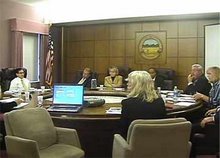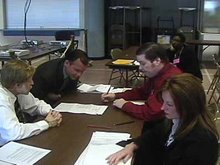Saturday, May 12, 2007
How's the Cuyahoga Counting Coming?
Last week, as an Observer, I briefly visited the CCBOE to watch the handling of provisional ballots. The certified count, I've been told cannot start until after 10 days after the election, thus will begin on May 21.
The process this time appears and feels calm and procedurally very sound. Forms have been simplified and made more user-friendly, procedures have been spelled out, (and I was given a copy, though I haven't had time to go through it carefully,) and unlike November, it can be made clear to any onlooker exactly who is to do what.
As of last Wednesday, there were approximately 407 provisionals, plus 14 absentee provisionals. As of Thursday, 356 of those had been approved, with the remainder still going through another (3rd) round of checking.
The areas of my concern for checking, that are reflected by this part of the provisional process, but are outside of this department's control, remain as:
1. People unnecessarily forced into provisional ballots and possibly having those provisionals ballots rejected ie. being disenfranchised - because of unresolved problems with the Diebold , DIMS registration system, thus appearing as "Not Registered" voters. Problems include:
• original registrations that were lost between hard copy registration cards and scanning into the DIMS electronic system;
• the system "mysteriously" dropping some registrations after they got in
• or it making it unnecessarily unwieldy or difficult for workers to safely pull up a search for a person by name or birth date, while not also risking losing the proper person's records if they accidentally click on the wrong choice.
In countywide elections there are usually too many "Not Registered" provisional rejections for the department to go back to the paper archives in a storage locker, to search out each one. So unless there is one office or person to call for voters who think they should have been given a regular ballot because they should have been registered at the precinct at which they appeared ( for instance, they'd voted there before and/or they're with a spouse who had also voted there before and was in the poll book, but they were not, etc.) these people's votes, unknown to themselves, get rejected.
And unless it is caught, thus fixed, their "Not Registered" provisional and following rejection could happen election after election.
2. Provisional votes needing to be rejected by law, because of "Missing ID" and/or they did not fill in the affirmation statement on the provisional envelope. In most of the cases I saw, as Mike DeFranco, the department manager, went through that pile with me (since I cannot touch the ballots) the poll worker also had not filled out his or her portion of those envelopes either. This indicates that most probably, many of those "Missing ID's can be attributed to poll worker "errors" - in their not fully informing the voters about what to do, and helping the voter to check that they've done it right.
Though these people have 10 days to come to the board to provide more information, so their votes could count, and were supposed to be given a notice to that effect, I sense that very few remember, or bother to make that trip downtown.
I do not feel confident that more poll worker training can adequately solve this problem, that was also evident last November.
Under pressure at the polls, poll workers forget and get confused about provisionals.
As Mike DeFranco stated, he estimates that a minimum of 50% of provisional ballots that his department needs to reject by law, have been caused by poll worker error. His solution: a dedicated provisional station at each polling location, where poll workers are intensely trained on helping voters get to the right precinct table or polling location, to search for possible registrations that have gotten "lost" to the pollbooks/ voters who claim they should be registered in that precinct, and to properly fill in the forms.
3. Voters who must vote provisionally, and then possibly whose vote is then rejected, because they've gone to the Wrong Precinct. In November, among small samples checked, at least 1/2 of those voters were in the right polling location, but at the wrong precinct table!
There are many possible solutions to this problem, including stationing a greeter who interfaces with each voter and by address, directs him/her to the right table/location; putting up easily seen large signs/flags at each table indicating the precinct designations, etc.
This "Wrong Precinct" category of provisional rejections in November was way over 1,000, close to 1600-1800 as I remember, and was the largest category of vote rejection. This is a huge number of people who came to the polls to vote, but ultimately were disenfranchised.
My solution to some of these provisional problems is also, to allow Same Day Registrations. I cannot figure out why such welcome to the process would be contraindicated, as long as the voters come to the polls with proper ID's anyhow.
4. The next important reports, highly problematic in the past, which I'll thus be checking for May, will be the number of people who signed in at the polls (number of voters) compared with the number of ballots cast (number of votes) per precinct.
In the past there have been HUGE discrepancies per precinct, in a many of over 1400 precincts, which could indicate a total "offness" (less or more) of voters to votes - that could improperly change the winners of some races.
In the past, the board has allowed for a discrepancy of 25, and in May '06, of 35, between numbers of votes and voters per precinct, before it's reported to the board/public, and before results certification.
Again with 1434 precincts, this still allows far too great a total discrepancy to be able to know that the right winners have "won", and "that every vote counts."
This "gap" must "allowance" must be greatly lowered in the future.
We'll see if those numbers match more closely this time, and if not, what the possible sources of such discrepancies may be.
One issue with DREs that makes this problem so hard to resolve is that even if the problem is with the DRE itself, no matter how many times one runs the report of how many ballots there were in the precinct, the machine always tells the same number - but never indicates where inside the code votes were added or lost. With paper, one can go back and actually count and review the votes and find the sources of the problem.
The process this time appears and feels calm and procedurally very sound. Forms have been simplified and made more user-friendly, procedures have been spelled out, (and I was given a copy, though I haven't had time to go through it carefully,) and unlike November, it can be made clear to any onlooker exactly who is to do what.
As of last Wednesday, there were approximately 407 provisionals, plus 14 absentee provisionals. As of Thursday, 356 of those had been approved, with the remainder still going through another (3rd) round of checking.
The areas of my concern for checking, that are reflected by this part of the provisional process, but are outside of this department's control, remain as:
1. People unnecessarily forced into provisional ballots and possibly having those provisionals ballots rejected ie. being disenfranchised - because of unresolved problems with the Diebold , DIMS registration system, thus appearing as "Not Registered" voters. Problems include:
• original registrations that were lost between hard copy registration cards and scanning into the DIMS electronic system;
• the system "mysteriously" dropping some registrations after they got in
• or it making it unnecessarily unwieldy or difficult for workers to safely pull up a search for a person by name or birth date, while not also risking losing the proper person's records if they accidentally click on the wrong choice.
In countywide elections there are usually too many "Not Registered" provisional rejections for the department to go back to the paper archives in a storage locker, to search out each one. So unless there is one office or person to call for voters who think they should have been given a regular ballot because they should have been registered at the precinct at which they appeared ( for instance, they'd voted there before and/or they're with a spouse who had also voted there before and was in the poll book, but they were not, etc.) these people's votes, unknown to themselves, get rejected.
And unless it is caught, thus fixed, their "Not Registered" provisional and following rejection could happen election after election.
2. Provisional votes needing to be rejected by law, because of "Missing ID" and/or they did not fill in the affirmation statement on the provisional envelope. In most of the cases I saw, as Mike DeFranco, the department manager, went through that pile with me (since I cannot touch the ballots) the poll worker also had not filled out his or her portion of those envelopes either. This indicates that most probably, many of those "Missing ID's can be attributed to poll worker "errors" - in their not fully informing the voters about what to do, and helping the voter to check that they've done it right.
Though these people have 10 days to come to the board to provide more information, so their votes could count, and were supposed to be given a notice to that effect, I sense that very few remember, or bother to make that trip downtown.
I do not feel confident that more poll worker training can adequately solve this problem, that was also evident last November.
Under pressure at the polls, poll workers forget and get confused about provisionals.
As Mike DeFranco stated, he estimates that a minimum of 50% of provisional ballots that his department needs to reject by law, have been caused by poll worker error. His solution: a dedicated provisional station at each polling location, where poll workers are intensely trained on helping voters get to the right precinct table or polling location, to search for possible registrations that have gotten "lost" to the pollbooks/ voters who claim they should be registered in that precinct, and to properly fill in the forms.
3. Voters who must vote provisionally, and then possibly whose vote is then rejected, because they've gone to the Wrong Precinct. In November, among small samples checked, at least 1/2 of those voters were in the right polling location, but at the wrong precinct table!
There are many possible solutions to this problem, including stationing a greeter who interfaces with each voter and by address, directs him/her to the right table/location; putting up easily seen large signs/flags at each table indicating the precinct designations, etc.
This "Wrong Precinct" category of provisional rejections in November was way over 1,000, close to 1600-1800 as I remember, and was the largest category of vote rejection. This is a huge number of people who came to the polls to vote, but ultimately were disenfranchised.
My solution to some of these provisional problems is also, to allow Same Day Registrations. I cannot figure out why such welcome to the process would be contraindicated, as long as the voters come to the polls with proper ID's anyhow.
4. The next important reports, highly problematic in the past, which I'll thus be checking for May, will be the number of people who signed in at the polls (number of voters) compared with the number of ballots cast (number of votes) per precinct.
In the past there have been HUGE discrepancies per precinct, in a many of over 1400 precincts, which could indicate a total "offness" (less or more) of voters to votes - that could improperly change the winners of some races.
In the past, the board has allowed for a discrepancy of 25, and in May '06, of 35, between numbers of votes and voters per precinct, before it's reported to the board/public, and before results certification.
Again with 1434 precincts, this still allows far too great a total discrepancy to be able to know that the right winners have "won", and "that every vote counts."
This "gap" must "allowance" must be greatly lowered in the future.
We'll see if those numbers match more closely this time, and if not, what the possible sources of such discrepancies may be.
One issue with DREs that makes this problem so hard to resolve is that even if the problem is with the DRE itself, no matter how many times one runs the report of how many ballots there were in the precinct, the machine always tells the same number - but never indicates where inside the code votes were added or lost. With paper, one can go back and actually count and review the votes and find the sources of the problem.
Subscribe to:
Post Comments (Atom)






No comments:
Post a Comment